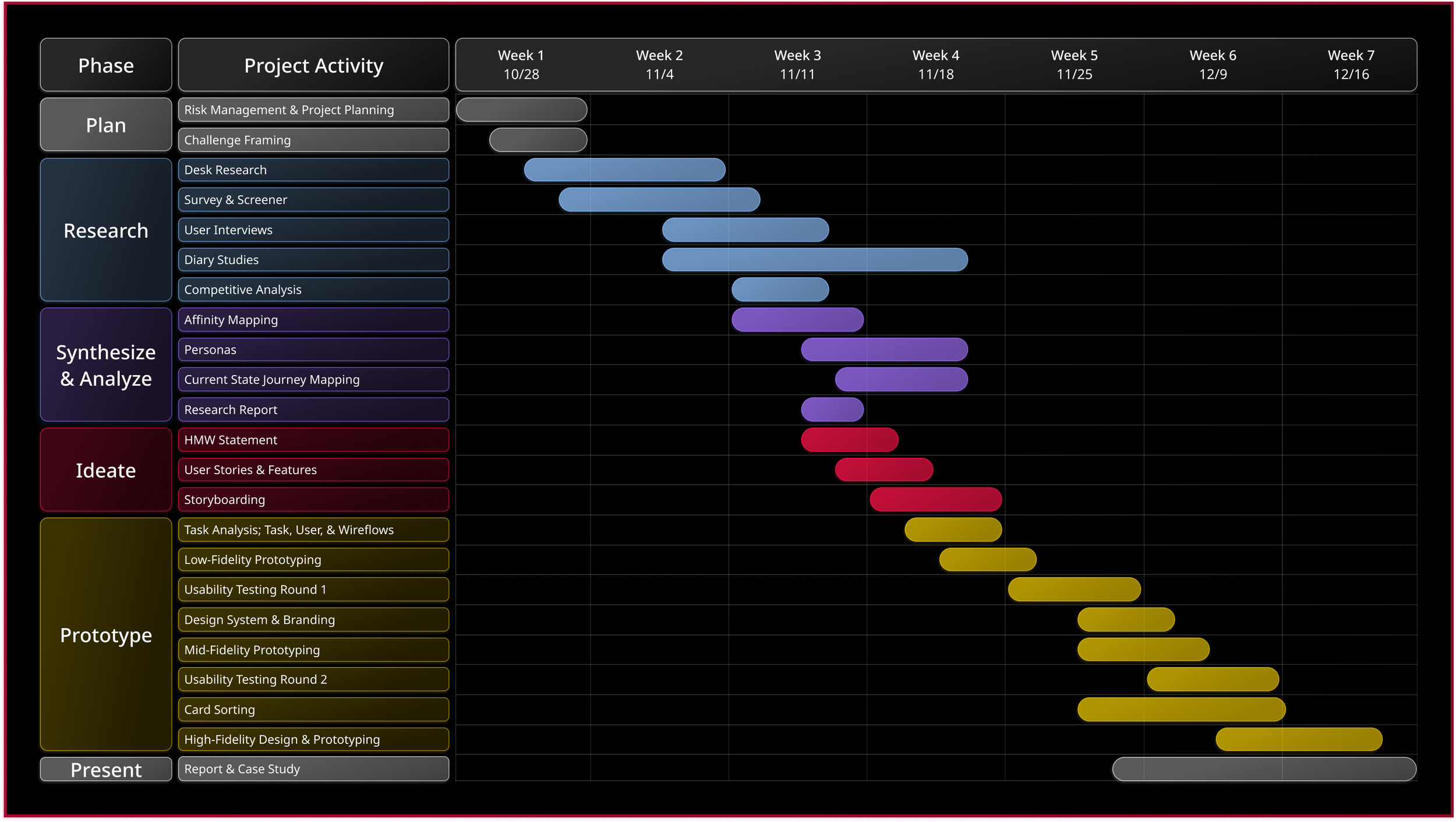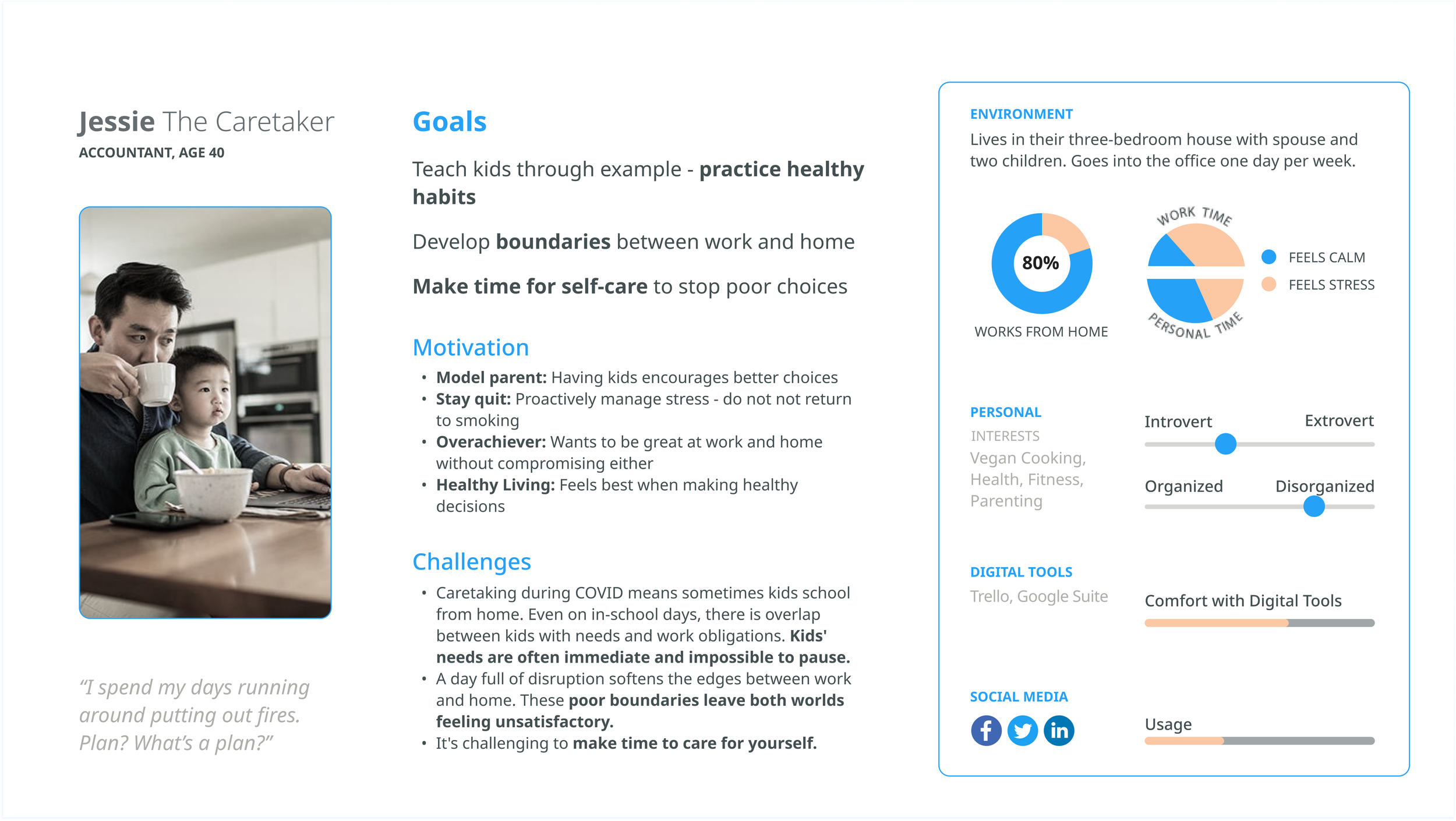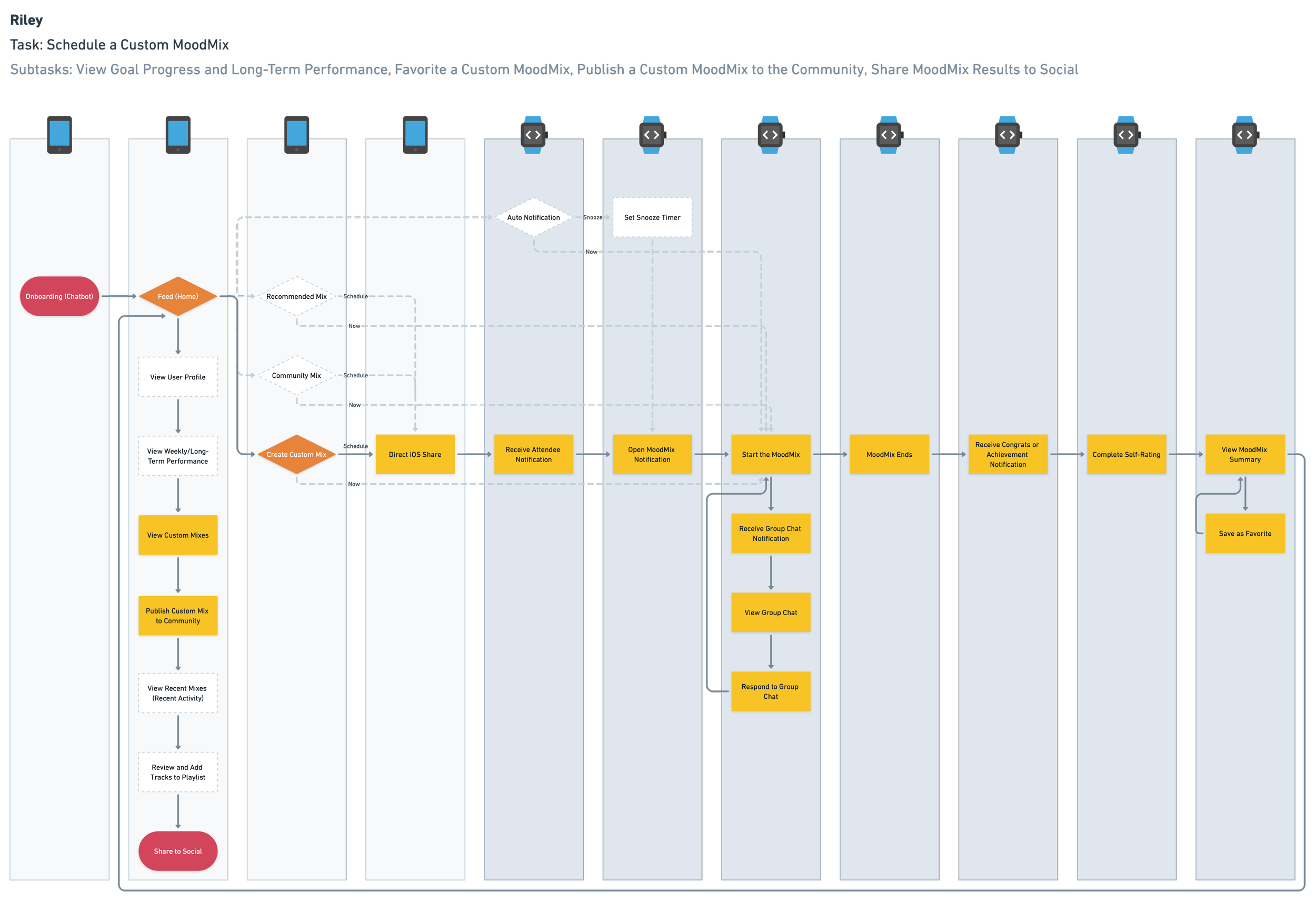UX Research Case Study:
MoodMix
Stress-Relief, Vol. 2. Remixing Wellness & Music for a Relaxed & Productive Work-From-Home Vibe
Project Details
Research Categories: Generative, Evaluative
Project Type: Team, MICA UX Design M.P.S. Industry Challenge
Roles & Contributions: Researcher, Project Manager
Project Timeline: 7 Weeks
Faculty Advisors: Patricia Reyna-Wright
Note: The visuals on this page come from the team's final UX research report and presentation and are meant to showcase our research and design abilities.
High-Level Research Objectives
Examine stress through a holistic health lens and explore both established and innovative treatment and prevention methods
Understand how work-from-home (WFH) employees experience stress and identify unique environmental triggers
Research and evaluate ways WFH employees can incorporate stress-management skills into their routines
Prototype Mockup: Curated MoodMix
The Challenge
With companies increasingly implementing WFH strategies, employees face new obstacles in balancing work and family responsibilities. Although not without its perks, this new work environment can make prioritizing tasks and setting boundaries difficult. For many, these stressors negatively impact mental health and job performance.
Problem Statement
WFH employees need a way to help manage their stress for a better work-life balance and increased professional success.
So, how might we engage and motivate employees to develop habits that lead to a more relaxed and productive WFH environment?
Methods
This team-based project took place over seven weeks. As the project manager, I was responsible for planning and coordinating all activities to deliver a solution meeting the project's requirements and constraints. In addition, I placed a high priority on research for this project and helped lead these activities. Below, I highlight some of the key methods our team utilized.
Project Timeline
Desk Research
We began our discovery by consulting 30 sources, including many scholarly and peer-reviewed articles. In particular, we needed a comprehensive understanding of stress, including its mental, emotional, and physical facets. We also needed to identify techniques and treatments for stress relief and management to guide our future design decisions.
Surveys
Surveys helped the team gain broad insights from real-world WFH employees, providing a mix of quantitative and qualitative data, including demographics. In addition, the survey served as a screener and recruitment tool for future research. We received responses from 29 participants representing various WFH experiences, including hybrid workers.
Survey Findings: Work from Home (WFH) Employee Attitudes
Interviews
We needed to get deeper qualitative insights into the WFH experience and understand the goals and challenges of these workers as they relate to stress and mental health. So we developed a discussion guide using desk research and survey findings and conducted six remote, semi-structured interviews, each with a moderator and observer to take supplementary notes. On average, these in-depth conversations lasted an hour, and the 2:1 ratio allowed for increased engagement and data capture. Immediately following each interview, the moderator and observer debriefed, providing an additional perspective on the initial takeaways.
Affinity Mapping
We synthesized the data from our interviews using FigJam. This collaborative approach provided additional perspective and higher confidence in the emerging themes. Afterward, we organized these themes into higher-level groups, which were the basis of our key insights.
Recorded User Interviews
Affinity Mapping Theme: Wellness & Breaks Help Manage Stress
Diary Studies
We conducted three diary studies to supplement our interviews, providing more contextual insights. This approach was critical as WFH is a long-term experience, requiring a longitudinal method for a more complete understanding of the problem. Participants received unique Google Forms where they recorded their thoughts and feelings before, during, and after each day for an entire work week. In addition, participants were asked to rate their stress levels and perceived levels of work-life balance at each check-in, allowing for a qualitative comparison of these attitudes. The findings from the diary studies were instrumental in shaping our design choices.
Personas
Our findings indicated that stress affects people in various ways. Coupled with the variety of WFH experiences, we needed to establish user archetypes, each with their own goals and challenges. These personas helped ground and guide our solution to the needs of users.
Current State Journey Mapping
Working from home is experienced over time, so we created current state journey maps using our findings and insights to capture and visualize the actions, feelings, and perceptions of WFH employees throughout a typical workday. This approach allowed us to identify pain points and prioritize opportunities for workers to manage stress.
Persona: Jessie, the “Caretaker”
Journey Mapping: Jessie’s Current WFH Experience
Competitive Analysis
Towards the end of our generative research, we knew our approach would most likely be centered around wellness. Therefore, we needed a competitive analysis to identify opportunities with many products already in this solution space.
Task, User, & Wireflows
After completing a task analysis for each persona, we created task, user, and wireflows to organize and communicate MoodMix's information architecture. These deliverables helped kick off the design process, and continuous updates were made based on feedback from usability testing.
Riley’s Userflow: Scheduling a Custom MoodMix
A Portion of Riley’s Wireflow Visualizes Custom MoodMix Scheduling
Usability Testing
We needed to evaluate our design assumptions to ensure a user-centered product. With a strong emphasis on research, we completed two rounds of user testing on both low and mid-fidelity prototypes. We recruited seven participants from our survey/screener, ensuring that both personas were represented. We designed our solution for mobile and wearable, so we included Apple Watch users for relevant feedback. We used the rose, bud, thorn technique to synthesize the data and prioritize prototype updates.
Card Sorting
Our solution centered around wellness, and our competitive analysis provided a general idea of how these activities could be categorized and paired with music. With this foundation, we conducted two rounds of unmoderated card sorting with 19 participants (total). The first round was open to help identify potential categories, and the second round was closed to refine. Afterward, we analyzed the results using a similarity matrix and dendrogram, helping us finalize these categories for the high-fidelity prototype.
Best-Merge Method Dendrogram Helps Categorize Activities
Similarity Matrix Visualizes & Quantifies Activity Groupings
Key Research Insights
The WFH environment has unique stressors.
Living and working in the same physical space can strain WFH employees in specific ways. Our research found these stressors can be broadly categorized into three groups: the erosion of boundaries, new distractions to workflows, and complex communication lacking the human element.
The lack of physical boundaries makes it challenging for employees to recreate the physical and mental separation between work and life, further constrained by the size of their living space. The lack of personal and professional boundaries makes it difficult for workers to "clock out," with participants reporting that supervisors did not respect their personal time.
The home environment introduces new distractions into the workday, with participants reporting children, dogs, deliveries, and sounds as having the most significant impact on their work activities. An increased sense of immediacy makes prioritizing professional and personal activities a challenge.
Work activities, including collaboration, can be more challenging in the WFH environment. Multiple and occasionally overlapping communication channels require employees to schedule formerly organic interactions with colleagues, and participants report missing the bonding and camaraderie of the office.
“I miss the organic interactions with colleagues that naturally happen when I’m in the office.”
-Participant U02
WFH: Better for some, not-so-good for others.
Many employees surveyed (90%) enjoy working from home, with 69% reporting less stress and 80% reporting more work-life balance, indicating these variables are mutually inclusive but not one and the same. However, a substantial minority of users surveyed are not seeing improvements, with 31% experiencing more stress and 21% less work-life balance, and further underscoring this distinction. It's tempting to assume that decreased stress provides increased work-life balance, but our research suggests that although related, these variables are somewhat independent. In particular, including self-assessment ratings in the diary studies helped pinpoint this phenomenon. This surprising insight allowed for a more nuanced understanding of the WFH environment and helped shape our final solution.
Stress and Work-Life Balance: Related but Independent Variables
“This morning was a challenge… My son can sense that we are both in the house but not necessarily available to him.”
-Diary Study Participant U03
Positive mood states manage stress and promote productivity.
Desk and user research emphasize the power of Positive Mood States (PoMS) in regulating and managing stress levels and underscore the profound effects these affective states have on mental, emotional, and physical health. Not only can PoMS help relieve stress, but research indicates they can act as a "buffer," helping people become more resilient to future stressors, promote creativity, and increase productivity (Linden 2005; Fagan 2017). PoMS can be triggered through various activities, including physical activity, social bonding, taking breaks, and music, and studies show that people have an innate desire to maintain this positive state (Carver and Scheier 1981). In fact, many of our research participants reported many of these activities in their stress management routines, helping to confirm their effectiveness.
Note: For further information on findings and insights, please contact me.
“…I did get antsy and tired of sitting so it was nice to… walk to the post office on my lunch break when I was feeling restless.”
-Diary Study Participant U02
Research Impact
User Impact
MoodMix helps users better manage their stress using PoMS, which is proven to alleviate the mental, emotional, and physical symptoms and make them more resilient to future stressors. Our research highlights that WFH employees experience and manage stress differently, underscoring the need for a customizable solution that respects their preferences while motivating them to build new habits.
Central to MoodMix are the "mixes" themselves: curated or customized combinations of calming or energizing wellness activities with a matching soundtrack or soundscape. Users select or build a mix based on how they want to feel (the vibe) and can be done individually or with others, scheduled in advance, or taken when stress levels peak. Biometric data combined with self-reporting help track results and motivate.
MoodMix can be used with or without the Apple Watch (with more limited biometric reporting), combining evidence-based wellness modalities for a fun and engaging experience. Users are encouraged to take time for themselves for improved health, increased productivity, and a better work-life balance.
Prototype: Group MoodMixes with Chat
Phase 1 Features
MoodMix Community
Music Streaming Integration
Social Media Integration
Onboarding Chatbot
Stress Level Notifications
MoodMeasure Self-Reporting
Biometric KPI Reporting
Strategic Impact
As we considered various approaches to solving the pain points of WFH employees, it was evident that there were factors beyond our control: the lack of physical space at home, the management style of supervisors, and children's remote learning, just to name a few. A more nuanced understanding of the relationship between stress and work-life balance also helped us realize this. So, instead, we focused on where we believed we could affect the most change--stress management via PoMS. Research indicates multiple ways to achieve a positive mood state, allowing users to have flexibility in managing their stress while providing new and exciting opportunities for future features.
As a wellness-centered app, we wanted our solution to utilize biometric technologies and minimize external distractions when in use. With this in mind, we designed MoodMix as an MVP product for iOS and Apple Watch. We selected the Apple ecosystem due to a high level of synergy between mobile and wearable products and its #1 position in the smartwatch category, with 36% of the worldwide market share (Chen 2021).
Phase 2 of MoodMix will expand to other wearable formats, including Android and Samsung Galaxy Watches. We also plan on exploring new features such as live mixes with expert MixMasters and an enhanced member community for additional social connectivity and motivation. Although further research will be necessary, brands like Peloton illustrate the potential of this concept.
Prototype Mockup: iOS Home Screen
Planned Phase 2 Features
Live MoodMixes Sessions
Enhanced Community Features
Platform Expansions
Android, Samsung Watch
Garmin Venu Series
Fitbit
Business Impact
We found that a substantial minority of employees are negatively affected by the WFH experience. However, that is not to say the remaining majority of WFH employees are entirely stress-free. Quite the contrary, our survey found that 90% of workers experience some stress when working from home. Therefore, a solution targeted at the needs of this minority improves the WFH experience for everyone.
Zooming out even further, we know everyone experiences stress (National Institute of Mental Health). A benefit of the PoMS approach is that it is not limited to a WFH context. With this in mind, we believe that MoodMix has immense potential, especially considering the tremendous growth in the fitness and wellness app segment, with an expected annualized growth rate of 14.72% through 2026 (Statista 2022). A complete business plan is the next logical step to investor funding and commercialization. Part of this plan will include a profit model with ad-supported, subscription, and hybrid approaches having been discussed.
Reflections & Learnings
The value of a risk management plan cannot be stressed enough. Nothing goes exactly as planned, and being prepared in advance makes navigating the changes more manageable and keeps the project on course.
Recruiting the right participants is crucial to getting quality user feedback. As an iOS and Apple Watch product, we needed to gather data from users with experience on both platforms. The insights of Apple Watch users were tremendously beneficial as most of the product team were not users themselves.
The diary study is a powerful research method that sacrifices quantity for quality and requires substantial effort from the researcher in the form of consistent participant check-ins. We believe this effort was worth it, especially when combined with other methods like surveys and interviews, providing a critical insight that led the team towards the stress-management approach to the challenge.


















